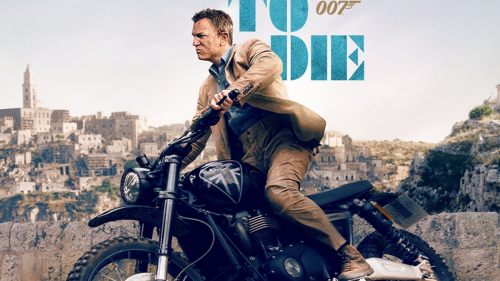James Bond In Spaaaaaaace: MOONRAKER At 40
The cinematic landscape of the late 1970s was dominated by Star Wars in more ways than one: the success of George Lucas’ movie soon had the industry scrambling to cash in on a new space craze, whether by accelerating the development of long-gestating science fiction projects as Disney did with Space Probe One, converting the reboot of a beloved SF TV show into a feature film as Paramount did with Star Trek: Phase II or taking a franchise formula into orbit as EON Productions did with the eleventh James Bond film, Moonraker.
1977’s The Spy Who Loved Me announced that “JAMES BOND will return in FOR YOUR EYES ONLY” but that idea was rapidly jettisoned in favour of the one spacey title in the Bond catalogue. An extension of an incomplete screenplay, Ian Fleming’s 1955 novel Moonraker takes the then-topical subject of British intercontinental ballistic missile development, sprinkles it with elements of his own involvement at the heart of British military intelligence during World War II, throws in a psychologically-driven yet monstrous villain, a female companion immune to Bond’s charms, and caps it all with a thrilling car chase and a suspense-filled climax.
Fleming found the structure imposed by bringing the story to novel length dissatisfying and was blasted by readers upset by the lack of escapism, but its early scenes fleshing out James Bond’s professional and personal life followed by a mission that strays no more than 85 miles from London allow him to explore the distance between the violent world Bond inhabits and the everyday lives he serves to protect.
Little of this made it into the movie, largely due to the way the Bond series had evolved away from the source material. Cherry-picking the more cinematic novels meant the early films hewed closely to Fleming’s plots despite breaking the internal continuity of Bond’s adventures, but the downbeat You Only Live Twice is notably short on their glamour, action and heroism, a problem screenwriter Roald Dahl resolved by discarding the majority of Fleming’s original storyline and inserting the remaining elements into the formula which underpins much of the Bond canon, so formalising a blueprint for future movies.
The elements might be shuffled around and duplicated, but the formula roughly breaks down like this: a strategic asset goes missing; Bond completes his previous mission; he flirts with Moneypenny; M delivers a mission briefing; Q provides gadgetry which will come into play at a crucial moment; Bond follows a lead to an exotic location; aided by an initially ambiguous female character, he survives an encounter with enemy agents; following the clues, Bond has further encounters with the enemy in further exotic locations; the female character becomes an ally; the villain’s elaborate lair is revealed; Bond is captured; the villain gives up the whole plan in a monologue; Bond escapes while defeating a bunch of henchmen; the villain is dispatched with a pithy line; the plan is thwarted; Bond and his ally escape the lair’s destruction and proceed directly to the bone zone.
Moonraker follows this scheme to the letter: its missing asset is a then-topical (and toy-friendly) Space Shuttle, its Q-gadget a wrist-mounted gun, its lair a sprawling space station, while its roster of exotic locations include Venice, Rio de Janeiro, the Amazon jungle, LAX and space itself. Ken Adam provides trademark monumental sets while Derek Meddings’ miniatures fill in where locations and effects are impractical. With Bond stalwarts Bernard Lee, Desmond Llewlyn and Lois Maxwell returning as M, Q and Moneypenny respectively and John Barry’s string-heavy score evokes the heavens, all the pieces are in place for a classic Bond movie.
Hewing to the formula like this delivers a crowdpleaser even as it strays further from the source material in its efforts to get Bond into space. Villain Hugo Drax crosses over but is shorn of both complexity and any clear motivation for his plan to repopulate Earth with a new master race, becoming just another megalomaniac trying to erase humanity, and while the death he plans for Bond makes the transition, here it’s in a conference room which is located directly under the Moonraker shuttle’s rocket engines for no apparent reason. Bond movies might often rely on propulsive narrative to blow past such lapses of logic, but the choices Moonraker makes only amplify them.
Take the return of metal-mouthed killer Jaws from The Spy Who Loved Me: he starts the movie by freefalling into a circus tent, becomes comic relief, then meets the right woman which is apparently all he needs to become one of the good guys. Goofiness aside, this puts the villain in the peculiar position of having a richer character arc than the hero, and by the time Jaws and Dolly clinch amid the swelling strings of Tchaikovsky’s Romeo and Juliet overture aboard the disintegrating space station, Moonraker has become massively removed from the core concept of a Bond movie.
This kind of tonal mismatch pops up throughout the film, from Corinne’s lyrically-shot but gruesome end to the cutesy Close Encounters Of The Third Kind nod that is the access code to the lab full of lethal orchid gas, or Bond turning up in spaghetti Western cosplay while Q’s team test their laser guns, not to mention the infamous St Mark’s Square hovercraft gondola scene. It all suggests a franchise confident its formula would allow it to get away with anything, and the box office returns agreed: Moonraker pulled in $210m worldwide, remaining the most successful entry in the franchise right up until GoldenEye in 1995. Chasing those Star Wars dollars had paid off despite critics complaining the film was both mindless and breathless.
From a 2019 perspective, Moonraker has, along with much of Roger Moore’s run as 007, not aged well. The sexism on display is positively jaw-dropping, most egregiously when Doctor Goodhead is revealed to be female: Lois Chiles’ stony-faced silence speaks volumes but can’t penetrate the sheer smarminess of a Bond it’s difficult to empathise with when imperiled. Drax at least racks up some woke points for promoting diversity amongst his future master race, although not enough to offset that global genocide plan. Full of moments and indeed whole scenes which feel like they would have been cut from any other script, Moonraker is often exactly the movie Bond parodies and critics have in their sights, yet the climactic battle as proto-Space Force shows up to trade laser beams with Drax goons is both gloriously demented and brilliantly executed: regardless of the writing, the film-making craft on display is anything but lazy.
When James Bond finally did return in For Your Eyes Only in 1981, it was a conscious back-to-basics effort with a deliberately grounded plot and actual thematic heft which drew on Ian Fleming’s work once more, setting a corrected course the franchise has broadly steered ever since. Moonraker had effectively killed rote adherence to the formula and no subsequent entry has so nakedly chased a trend, the franchise instead content to be its own thing.
Learning this lesson by pushing the limits of the formula is the real legacy of Moonraker. Sometimes the only way to find the line is to overstep it: James Bond in space turned out to be one giant leap too far.


